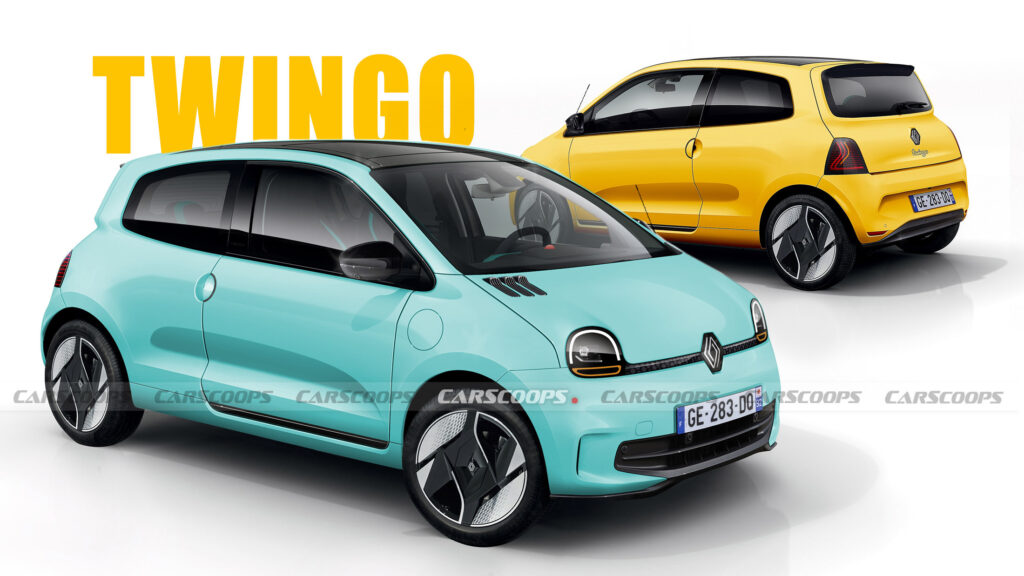With a sub-€20k price tag, the new Twingo wants to repeat the success of the original from the ’90s
2 hours ago
 –>
–> 
–>
Renault is targeting the affordable EV segment in Europe with the upcoming fourth generation of the Twingo that carries the spirit of the original into the modern era and promises a starting price below the €20,000 ($32,500) mark. The nostalgic design of the city car was closely previewed by a prototype in November 2023, with a European market launch expected by 2026.
Here at CarScoops, we have a reputation for being impatient so we compiled all the available information about the new Renault Twingo together with a set of speculative illustrations of the production version created by our associates.
More: The 2024 Renault 5 E-Tech Has A Hood-Mounted Charging Display
advertisement scroll to continue
Illustrations: Jean Francois Hubert/SB-Medien
The design of the Renault Twingo “Legend” prototype is heavily inspired by the 1992 original, retaining all the signature traits that made the Twingo famous, albeit in a slightly larger and more aerodynamic body with five doors instead of three. The production model is not expected to change much, especially after the public’s enthusiastic response to the concept.
As depicted by the above renderings, toned-down features could include simpler LED graphics on the semi-circular headlights and taillights, slightly smaller wheels, and changes on the trim for cost-cutting purposes. Of course, these won’t be enough to steal from the EV’s charming road presence, which is one of the major selling points in combination with affordable pricing.
Renault has not shown any photos of the interior, but judging from other models the Twingo will likely adopt sustainable materials for the upholstery. As the entry point in Renault’s future lineup, it could feature a simple dashboard layout with the essentials, further enhancing the practicality and clever packaging of the original.
Developed And Produced In Europe
Illustrations: Jean Francois Hubert/SB-Medien
The urban model is one of the 7 new EVs that will be developed and produced in Europe by Renault Group’s newly-formed Ampere Unit. While there is no official word on its underpinnings, it will most likely ride on the new EV-native AmpR Small architecture, which was formerly known as the CMF-BEV platform. Compared to the mechanically related but slightly larger 2024 Renault 5 E-Tech, we expect the new Twingo to use a cheaper battery pack and less potent electric motors, at least on the entry-level trims.
While there is no mention of targeted range and output figures, Renault promised a “best-in-class efficiency” of 10 kWh/100 km, and a 75% reduction in CO2 emissions over its entire lifecycle compared to the average European ICE vehicle of 2023. Additionally, the Twingo’s compact footprint will occupy 20% less ground space than the typical car found on European roads.
Luca de Meo said that the company is currently in discussions with OEM partners in a quest to share R&D costs, something that would allow them to achieve the low target price. He also described the new Twingo as an aspiring “game changer”, following the footsteps of the original.
As for the production location, the company remains tight-lipped other than confirming it will be in Europe. Reports suggest that the new Twingo will be produced in the Novo Mesto plant in Slovenia, just like the outgoing Twingo and the Clio supermini.
Target Price And Rivals
Photos: Renault
Renault promised a starting price below the psychological barrier of €20,000 ($32,500) and that is before you apply any market-specific subsidies. Furthermore, the EV will be available for leasing for less than €100 per month, and even cheaper for those who live in France and are eligible for the government-backed Social Leasing scheme.
The new Renault Twingo certainly doesn’t have an easy role to fill, as the urban EV segment will be full of compelling rivals when it arrives by 2026. The all-new Citroen e-C3 and the upcoming mechanically-related Fiat Panda also aim for a sub-€20k price tag promising to give Chinese EVs a run for their money. Furthermore, the VW ID.1 has been confirmed for a 2025 debut, while Hyundai, Kia, and Opel are already working on their proposals.
Note: The independent renderings are off-the-record and unrelated to Renault.

